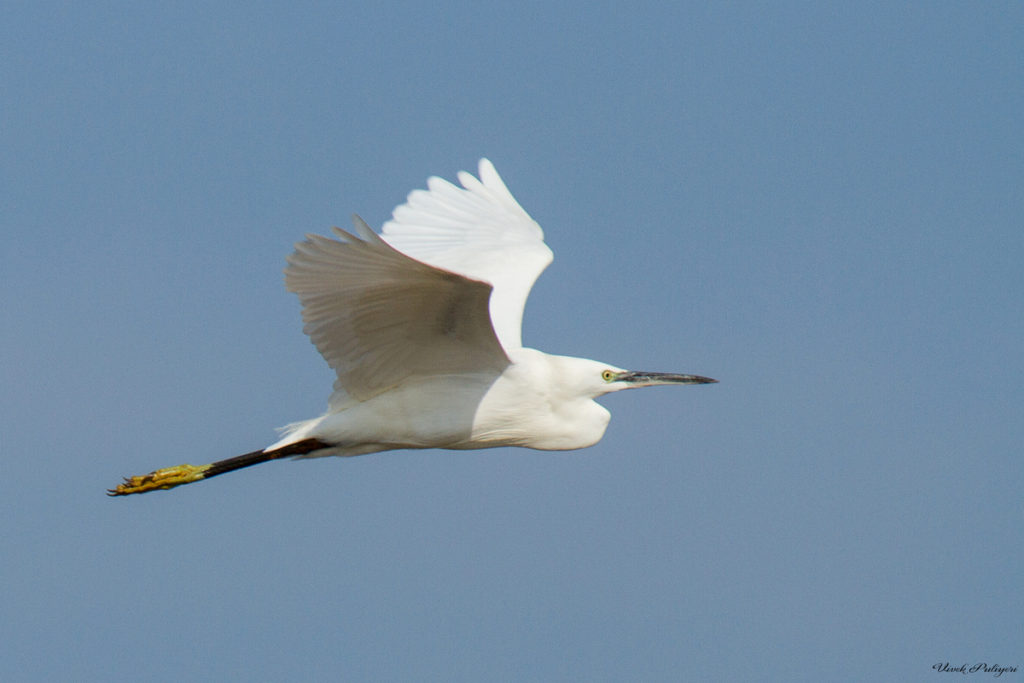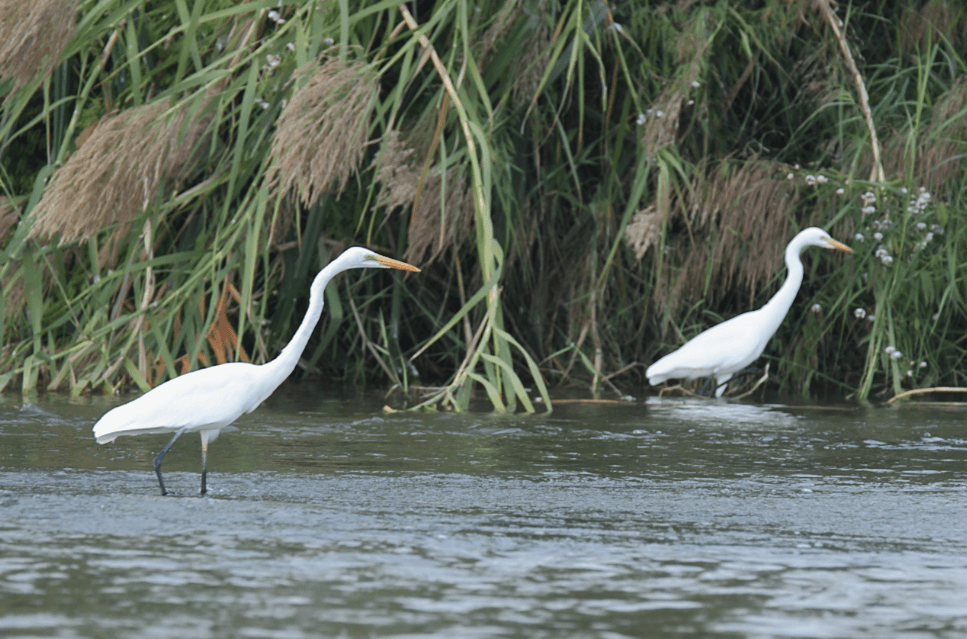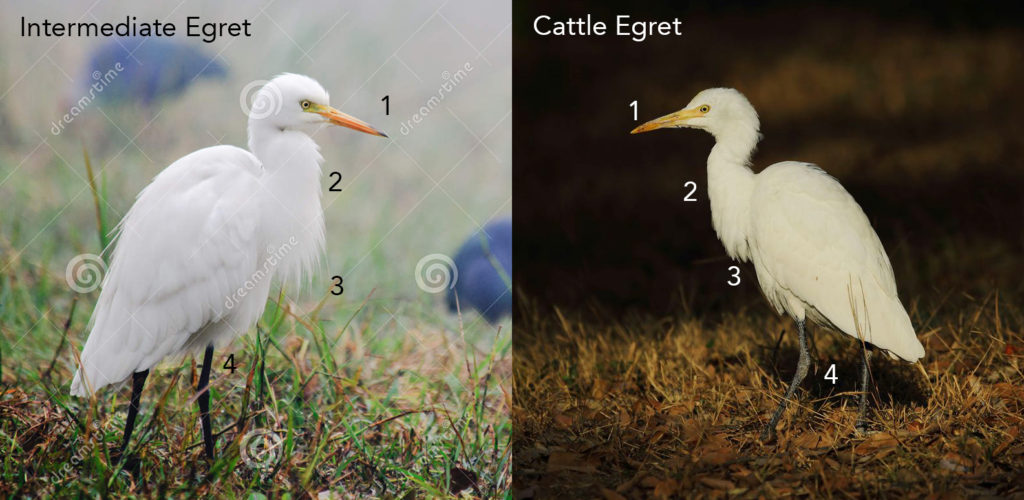Egrets are beautiful and elegant birds to watch. You'll often see them standing still over water and, in a flash, using their long, pointed bills to stab a fish or pick out an insect. No matter where you are in India, it is common to see one or many white birds looking for prey in wet fields and water bodies, or flying overhead to roost late in the evening.
A large flock of egrets © Sourav Maiti (view in checklist)
In spite of being quite common, they are one of the more confusing groups of birds for beginners and experienced birders alike. Although it is easy to identify a bird as an egret, the confusion arises when trying to identify the species itself. The names of egrets (eg Little, Intermediate and Great) tell us much about their size, but they can still be misidentified, especially if they are seen by themselves without a size reference. Luckily it's not just size alone that matters, and the different egrets have other features that can be used to identify them.
One such feature is their 'plumes', which they acquire in the breeding season. These are a a set of long, thin feathers on their back/dorsum, head or breast. Because different species grow plumes on different parts of the body, they can help in identification as well.
Cattle Egret Bubulcus ibis
The Cattle Egret is a ubiquitous and adaptable bird. This is a small and stocky egret, and gets its name from its habit of following cattle and other large animals (also tractors and JCBs!) to pick off any insects they might flush. Equally at home in light woodland, wetlands, farms and garbage dumps, it does not have any particular association with water. The Cattle Egret is worth familiarising oneself with as it is the egret species you are most likely to encounter no matter where you are birding.
 |
| Cattle Egret in breeding plumage (left, © Albin Jacob) and in non-breeding plumage (right, © Ramit Singal) |
| Habitat | Fields (especially if recently ploughed), farms, freshwater wetlands, forest clearings, garbage dumps in urban areas, etc. |
| Size | Smallest of our egrets. |
| Structure | Stocky in build. Large round head with relatively short thick bill, short legs and short, thick neck. |
| Breeding Plumage | Puffy looking head with orange head and neck, as well as orange dorsal plumes. |
| Bill | Blunt and thick, with upper mandible showing distinct dip at the tip. Mostly orange-yellow in all plumages. |
| In flight | Narrower, more pointed wings than other egrets, shorter legs. Relatively faster wing-flapping especially during and a little after take-off. |
Additional information: The subspecies that occurs in our region is Eastern Cattle Egret Bubulcus ibis coromandus. The Western Cattle Egret B. i. ibis is smaller with shorter neck and legs as well as a different breeding plumage.
Little Egret Egretta garzetta
The Little Egret is a delicate looking egret which frequents freshwater bodies of all types, including fast-flowing streams, slow-moving rivers, well-vegetated marshes, etc. It is small in size and neat in proportions – making it look quite graceful. Its obvious yellow feet set it apart from the other regularly occurring white egrets (except Western Reef-egret, the white morph of which usually has more extensive yellow on legs, and yellow on bill).
| Habitat | Associated with all water bodies. Typically stays away from coasts, but regular in estuaries. |
| Size | Small-sized, bigger than Cattle but visibly smaller than Intermediate and Great. |
| Structure | Very slender, looks almost delicate with graceful S-shaped neck, oval/triangular head, relatively longer bill. |
| Breeding Plumage | Two long plumes on head and down neck (the only white egret to have these), plumes on the back, on the breast. |
| Bill | Bill remains mostly dark/black in all plumages. In non-breeding plumage, base to lower mandible is visibly paler. |
| In flight | Yellow feet are visible. From similar Western Reef-egret by narrower, more pointed wings. |
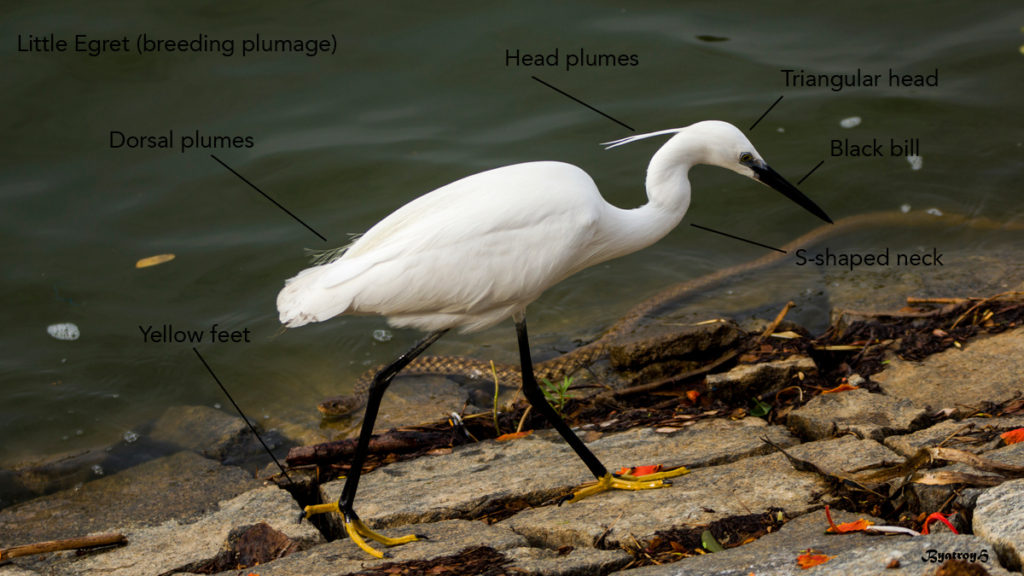
Little Egret in breeding plumage (with a Checkered Keelback in the background). Note the egret's head plumes, yellow feet, and slender structure but small size © Hemanth Byatroy (Checklist)
Additional information: Unlike several of our other egrets, the Little Egret is quite vocal and usually has a harsh call which it gives out in flight, alarm or for contact. You can listen to it here or here.
Intermediate Egret Mesophyx intermedia
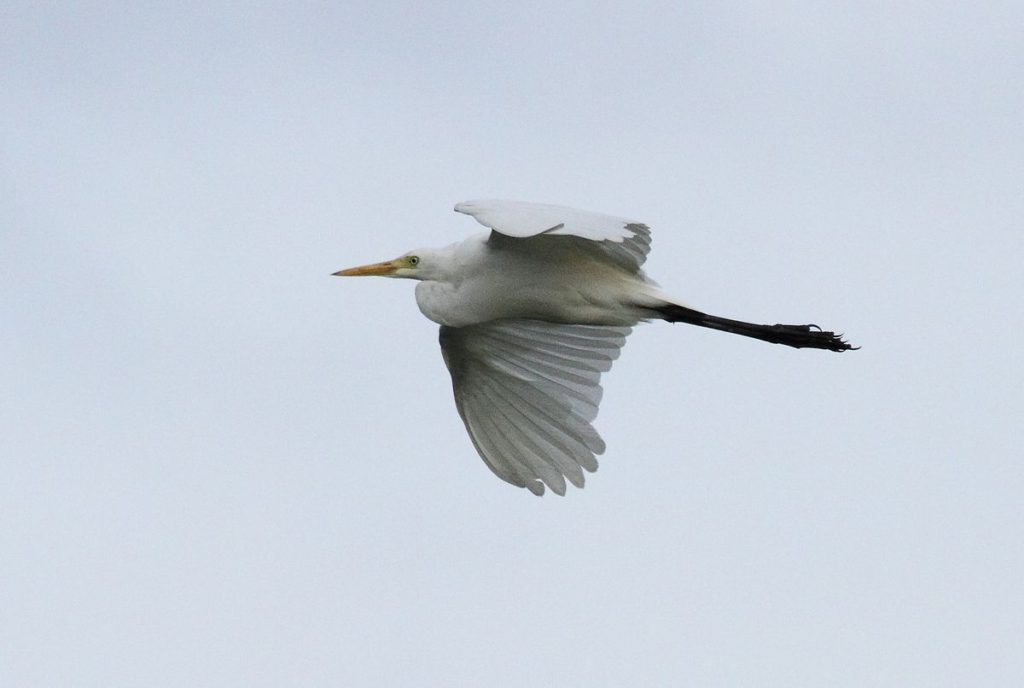
Intermediate Egret in flight. Note the roundish neck fold, short bill, round forehead © Albin Jacob (Checklist)
The most variable looking of our egrets, the Intermediate Egret can appear quite small or quite large when seen in isolation. Though some of the larger individuals may appear as large as Great Egrets, structurally (especially when the neck is retracted), birds may even resemble Cattle Egrets! The Intermediate Egret is a fairly stocky egret, due to its thick neck and large body, which also makes the legs look quite short.
| Habitat | Associated with all water bodies and wet fields, paddies. |
| Size | May look variable in size when viewed in isolation, but usually flocks with other egrets thus making comparison easier. Bigger than Cattle or Little Egret but smaller than Great Egret. |
| Structure | Stocky in build – note proportionally short bill and legs, round head, thick neck and large body (very rear-heavy due to the long tail). |
| Breeding Plumage | Bill becomes black and it attains plumes on the back/dorsum and the breast. |
| Bill | Proportionately shorter bill is yellow in non-breeding plumage and black in the breeding plumage. (Note: Lores are always yellow) |
| In flight | Broad wings and relatively shorter legs than Great Egret. Heavier rear usually apparent. |
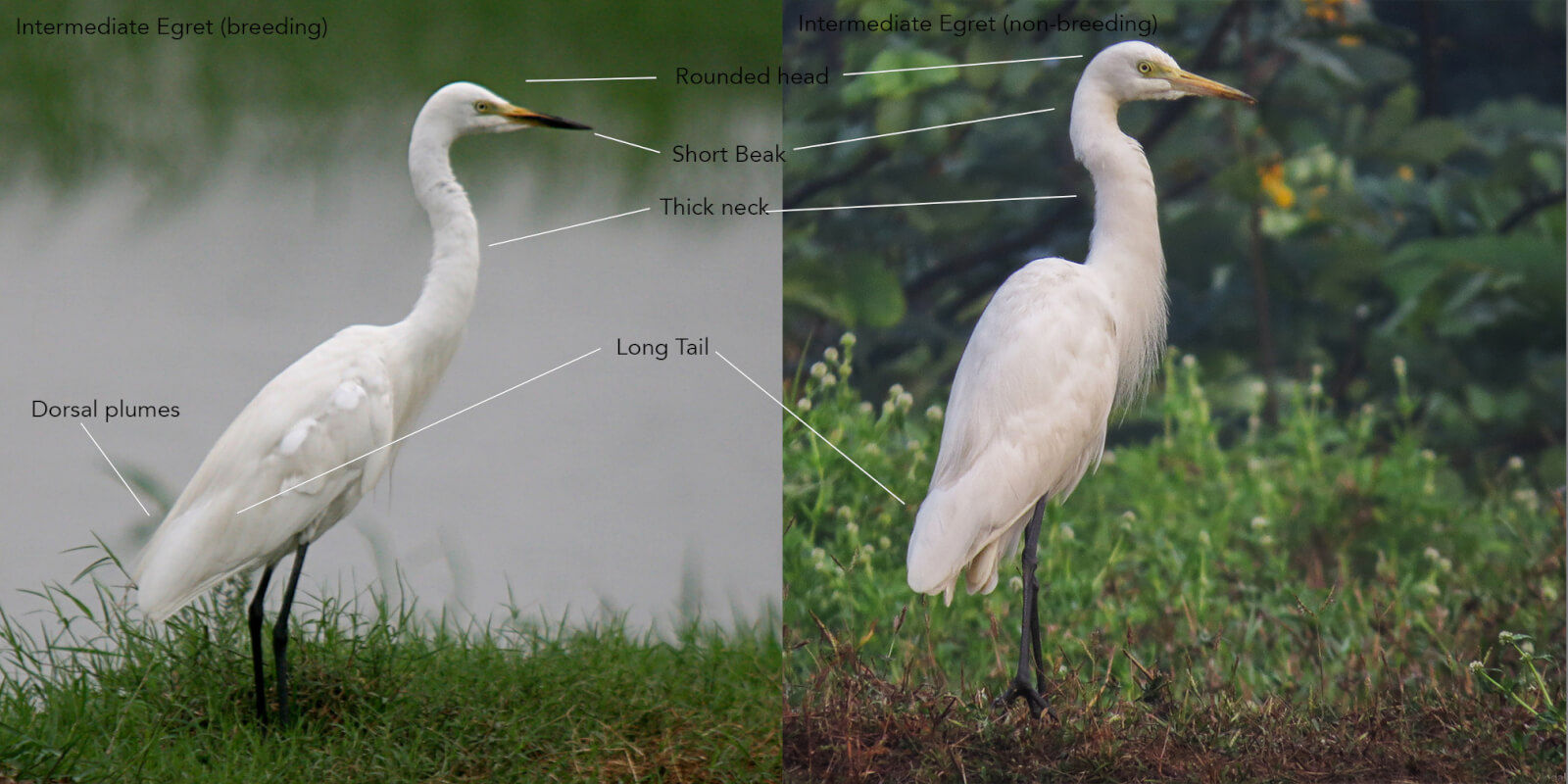
Intermediate Egret in breeding plumage (left) © Dinesh Singal and in non-breeding plumage (right) © Ramit Singal
The bird on the right is transitioning into breeding plumage and thus, has breast plumes.
The bird on the right is transitioning into breeding plumage and thus, has breast plumes.
Great Egret Ardea alba
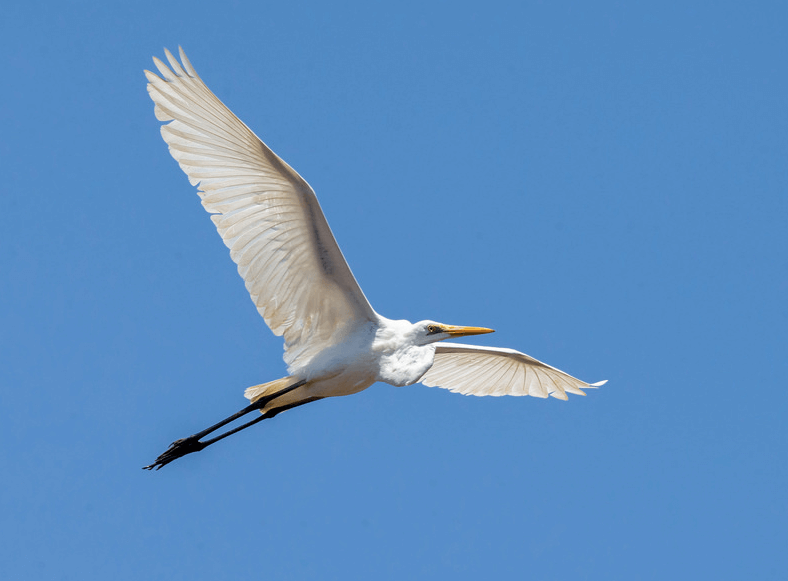
Great Egret in flight. Note long legs and bill, neck is angular when retracted, large wings © David Irving (Checklist)
The Great Egret is the largest of our egrets, with an overall lean look but distinctly heavy legs and bill. It is perhaps more similar to a Purple Heron in structure and jizz than the other egrets.
| Habitat | Associated with all water bodies, preferring slow-moving rivers, lakes and wetlands. |
| Size | Visibly large. |
| Structure | Structurally very lean with long neck showing prominent kink. Forehead is flat and in-line with long bill. Legs are long and body appears short – thus making it look very vertical. |
| Breeding Plumage | Attains plumes only on back/dorsum. |
| Bill | Long bill. Yellow in non-breeding plumage, and black in breeding plumage. |
| In flight | Broad wings and long neck and legs are apparent. Has the slowest, most relaxed flight of all the egrets. |
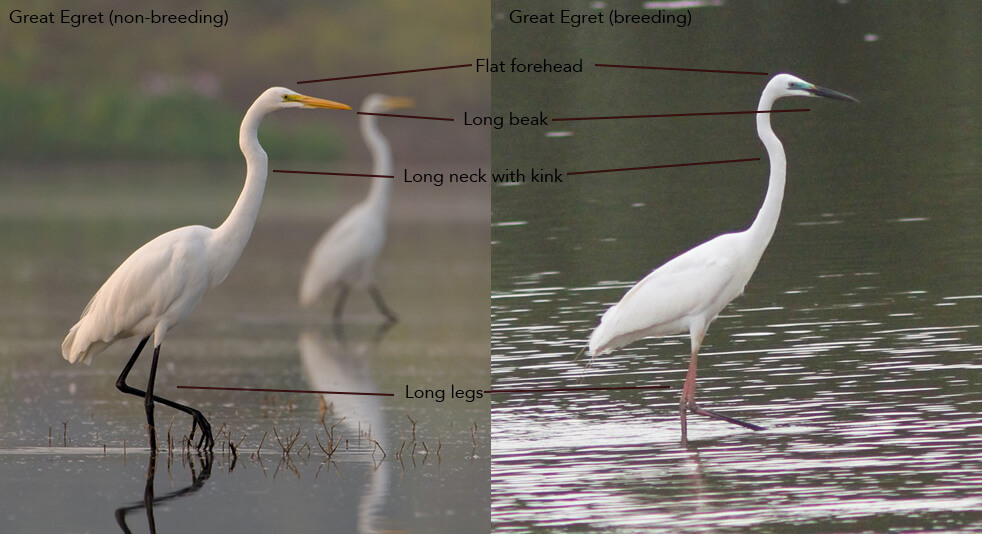
Great Egret in non-breeding plumage (left) © Palani Andavan Balasubramanian and in breeding plumage (right) © Jayan Thomas
Great vs Intermediate Egret
Several birders often have trouble distinguishing the Intermediate Egret from the Great Egret. A few features that make identification much easier are:
Image A:
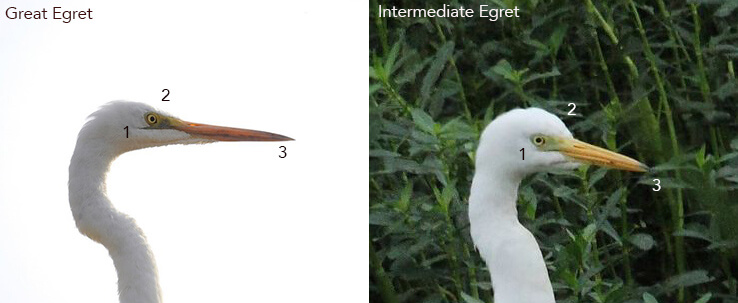
Great Egret (left) © Mittal Gala and Intermediate Egret (right) © Albin Jacob. Note length of gape line (1), shape of forehead (2) and length of bill (3).
Image B:
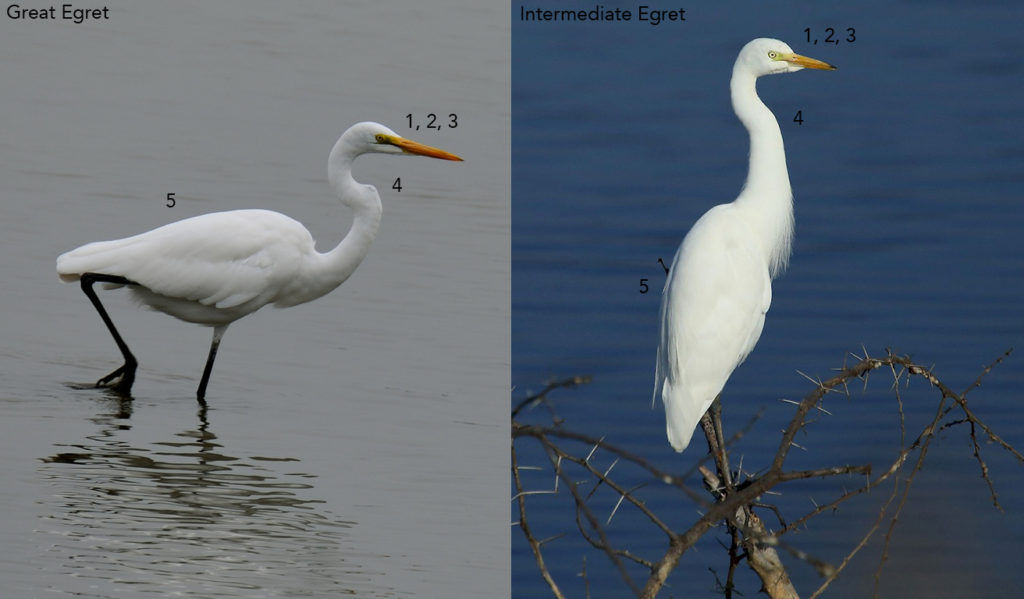
Great Egret (left) © Snehasis Sinha and Intermediate Egret (right) © Albin Jacob. Note shape and size of neck (4) and overall structure (5).
These differences are summarised below:
| Great Egret | Intermediate Egret | |
|---|---|---|
| 1 | Gape extending beyond eye | Gape ending at/before eye |
| 2 | Angular head | Round head |
| 3 | Longer bill | Shorter bill |
| 4 | Long neck with pronounced kink | Thicker, shorter neck |
| 5 | Large, long and lean structure | Stockier, heavy built |
Here is an image that illustrates these differences very well (can you tell which species is which?):
Intermediate vs Cattle Egret
In certain postures and when direct comparison is not possible, an Intermediate Egret can look quite similar to a Cattle Egret. Below are some pointers on how to distinguish between the two:
| Intermediate Egret | Cattle Egret | |
|---|---|---|
| 1 | Straight beak | Obvious curved tip to beak |
| 2 | Neck retracts a bit deeper | Shorter neck |
| 3 | Breast plumes in breeding plumage | No plumes on the breast. |
| 4 | Proportionally longer legs | Shorter legs |
Note: There will always be times when particular individuals may prove difficult to identify even with the best of views. Some times, one may just not get to see enough of the bird to be able to ID it. It is absolutely OK if that is the case and best to err on the side of caution. On eBird, you may use "White Egret sp." when conclusive identification is not possible.
Also: An article with Little Egret and the two Reef-Egrets will be coming soon.



















